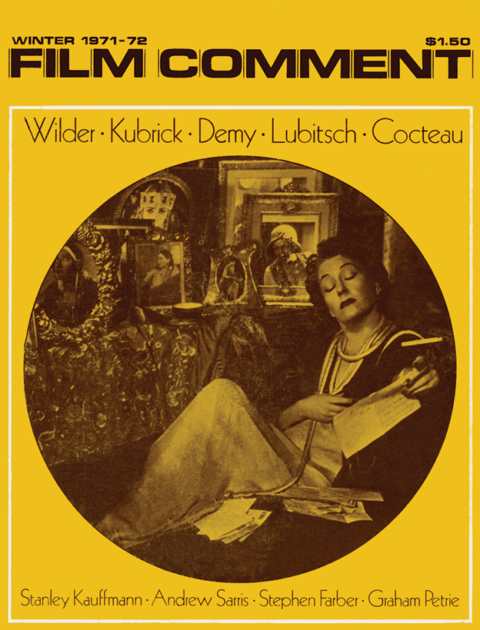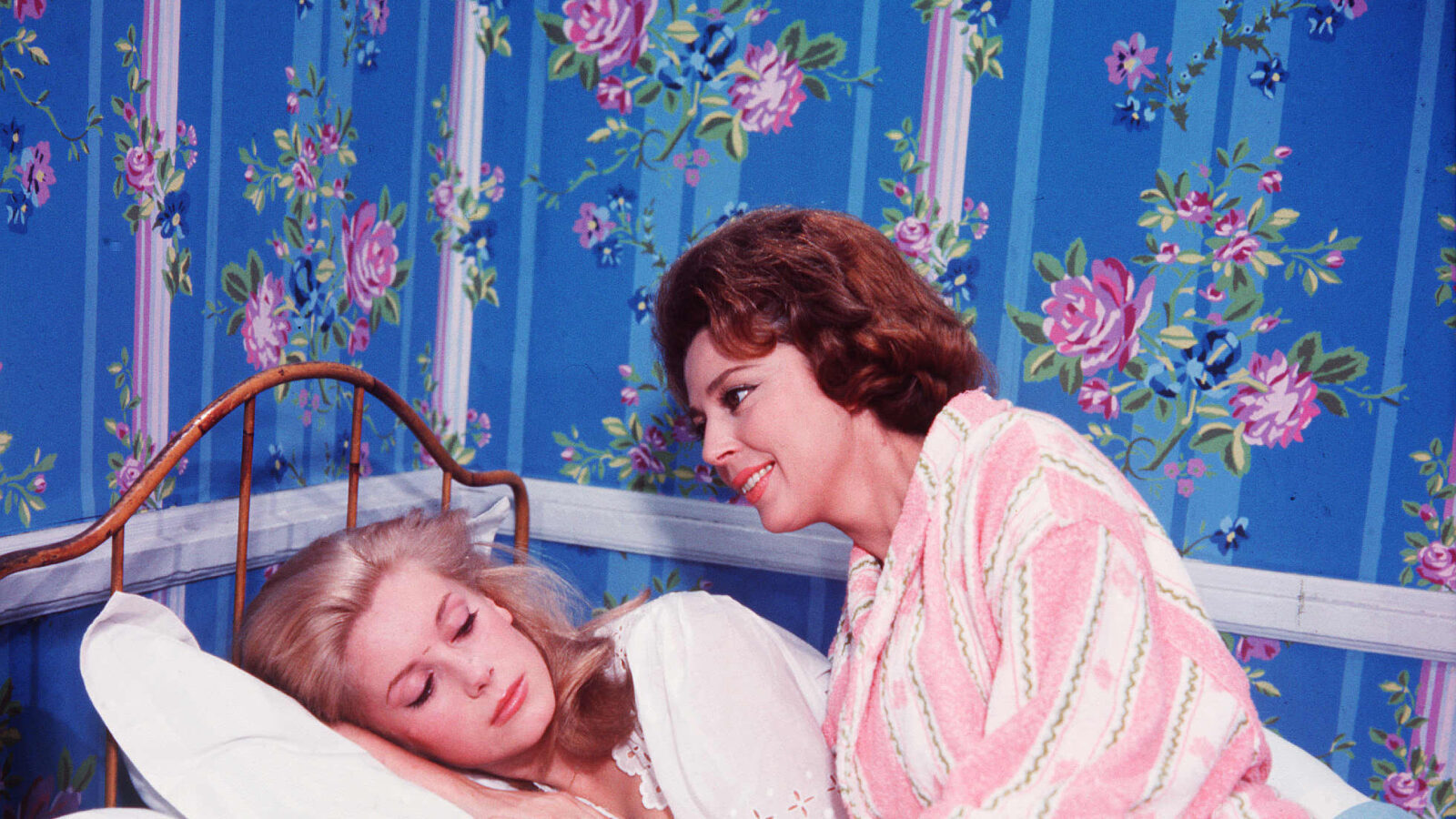
Jacques Demy
The meaning of a book is given, in the first instance, not so much by its ideas as by a systematic and unexpected variation of the modes of language, of narrative, or of existing literary forms.” —M. Merleau-Ponty, The Primacy of Perception
Although Merleau-Ponty’s observation can be applied to painting and filmmaking, as well as literature, traditional film criticism has tended to follow the pattern of traditional literary criticism in its concern to discover the “ideas” behind a work of art. The auteur theory, for example, whatever its other advantages, has generally contented itself with an examination of the thematic material present in a filmmaker’s work and with the assumption that, once a satisfactory continuity has been established there, the director’s greatness can be taken as proved. Jacques Demy’s films have suffered more than most from this limitation: a critic searching for serious thematic substance can easily find them trivial and lightweight, while defenders of Demy usually argue that, despite the glitter and apparent frivolity of the surface, serious moral ideas are waiting to be uncovered once this has been thrown aside. The obsession with establishing a solid “content” for the films seems to have affected even Demy himself:
I don’t like labels that classify you and file you away as a little ‘romantic.’ Perhaps Lola was romantic, but Les Parapluies de Cherbourg is not a romantic film. It’s a very realistic film. It’s about a young love affair that is broken up by the Algerian War. The people are very realistic and have plenty of problems and in the end their life is destroyed as a result of the Algerian War. It’s a very cruel film and a very realistic one; when they find each other again at the end there’s nothing possible for them any longer, their lives are quite different, they’ve gone different ways. And so because there is music and color and it’s a charming film, a poetic one…
It might be worthwhile leaving aside for the moment those elements which can be torn out of Demy’s films and rearranged to make him look and sound like any other filmmaker, and turning instead to the things which make him unique.
“At any given moment the accepted report of an event is of greater importance than the event, for what we think about and act upon is the symbolic report and not the concrete event itself.” —William M. Ivins, Prints and Visual Communications
Ivins’s book examines the process by which the technological inadequacy of the means of visual reproduction (especially of paintings and prints), from the Renaissance to the mid-nineteenth century, helped condition the Western eye to accept a limited and false notion of “beauty” that was finally destroyed by, among other things, the invention of photography, with its apparent ability to reproduce exactly and truthfully what was set before it. The 20th-century filmmaker has inherited a medium that can recreate the “concrete event” more accurately than any which preceded it; if he sees himself consciously as an artist, he will want to turn mere “visual reporting” into “visual expression” and manipulate the innumerable opportunities open to him in the ways in which a scene can be shot and the processed film rearranged. Later, the filmmaker became aware that the camera itself was not as objective as it had seemed, that the “concrete event” was altered simply by the fact of being photographed. The camera sets an artificial frame around the subject and distorts size, distance and spatial perspective; more than this, each viewer creates for himself a different version of the screen image, responding to, and perhaps literally seeing such things as color and depth in a totally different way from his neighbor.
Despite all the evidence, both technical and psychological, that the camera never conveys to the viewer exactly what he would see if he were looking at the photographed object; despite the realization that we have simply replaced one convention of seeing by another, the tendency of film criticism is to argue for visual (as well as psychological) realism as the chief characteristic of cinema as an art. As has been often enough pointed out, the dichotomy between the “illusory” and the “reporting” attributes of film were realized as early as Méliès and the Lumière brothers. For the greater part of the history of the feature film, however, most filmmakers accepted a formula that presented characters and situation which could be taken as “real,” yet were created by means of the illusionary devices—black-and-white film, sound effects, studio sets, back projection, camera angles and movement, trick photography, changes of focus and lens, background music and editing—inherent to the cinema as a whole and so much taken for granted that critics seldom bothered to make more than the most perfunctory comments on them. Few seem to have paid much attention to the paradox that the “real” world and the “real” people they were writing about were based so solidly and smoothly on deception.
At the present moment, however, this kind of unawareness is no longer possible. Filmmakers have begun to stress either that what they are creating is totally artificial by its very nature (Pier Paolo Pasolini’s “poetic cinema”) and that the characters and events are to be judged in that light, or, that the people they are showing are real people living their normal lives in front of the camera, and that a basic minimum or substructure of technical activity has to be accepted simply in order to get them on film. In the latter category would be films as diverse as the agitprop of Godard in See You at Mao [British Sounds], the mixture of personal and political concerns in William Klein’s Eldridge Cleaver, Black Panther, and Andy Warhol’s interest in people just being themselves in front of the camera.
Demy has expressed great admiration for Warhol in particular and American Underground film in general: “Because they are a kind of negation of cinema-yet positive. A new way of filming, of directing, a new language, and new ideas.” Perversely, perhaps, his own most recent film Peau d’Ane, made in 1970 after the visit to America which he says opened his eyes to a whole new complex of social, political, and aesthetic ideas, is probably his most artificial and “unreal” to date.
SOME COLORS
PETRIE: Have you any theories about the use of color in films?
DEMY: No, I’m not interested in that. I don’t like theories, I believe firmly in impulse. It’s true that each color express something, but that is unconscious. I know, for example, that for Les Parapluies I wanted the umbrella shop, which is run by a woman, to be in very tender colors, rather sexual, rose colored, purplish-blue, violet. I wanted to convey a particular universe, but I don’t think that’s really important.
Do you plan the colors of a film in advance?
Certainly. Each detail, because I like that. I’m very fond of painting and I think that cinematic representation is also pictorial, in the sense that you offer a picture to the spectator and this should be something worth looking at, and you can always shape it for him. So I like to concern myself with each detail, for that reason. The wallpaper of the umbrella shop is designed in broad rose-colored vertical stripes divided by narrower green ones.
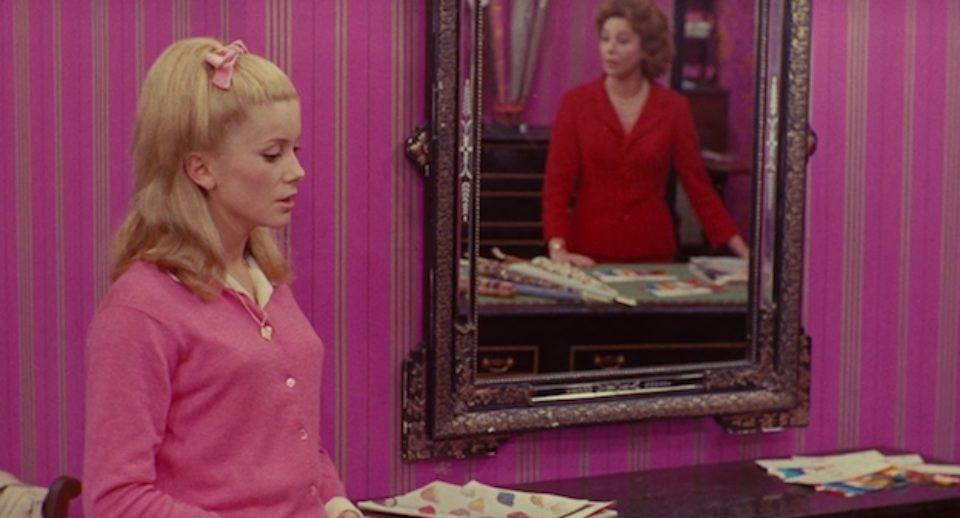
Les Parapluies de Cherbourg (Jacques Demy, 1964)
The wallpaper of the living room of the flat Genevieve and her mother live in reverses this—broad green stripes interspersed with narrow pink ones. In one scene the mother is set against this background dressed in a robe with green, pink, and white stripes, and Genevieve is seen later in a dress that reverses the pattern of the wallpaper of her bedroom—green flowers on a pink background as against pink flowers on a green background. The mother is dressed almost invariably in pink or at least with some pink or rose-colored accessory, such as the shawl she wears when Roland comes to have dinner with them. The green baize table in the shop allows Demy to set up some nice color harmonies between that, the mother’s pink suit, and the green-and-pink background. Genevieve is often dressed in pink too, most noticeably in the scene of her quarrel over Guy with her mother, where the latter wears this time an antagonistic red. The tender, sexual colors create not just an atmosphere, but a closed environment within which the mother and daughter move and into which they blend, and which the former wishes to keep totally under her control.
The outside world which threatens this harmony is presented in more violent, clashing colors—the various shades of red for the dancehall, the garage in which Guy works, and the bar in which he picks up the prostitute (“You can call me Jenny”). Jenny’s room is purple, the cafe in which Guy meets Madeleine after his aunt’s death is orange, the wall of the alleyway outside his aunt’s flat is a rather sickly olive green and in the scene in which Guy and Genevieve walk home before their first night together, this color is held in frame along with a background poster in stark red and yellow, injecting a disturbing and perhaps foreboding visual note into the aural and physical harmony of the rest of the shot. Guy’s bedroom, however, is in a blue that complements better the soft colors of Genevieve’s own world, and the jeweler’s shop in which the two women meet Roland, the suitor favored by the mother, is decorated in an acceptable pink.
The world of Les Demoiselles de Rochefort, however, is harmonious throughout. Demy uses a very wide color spectrum, in which blue, rose, yellow, lilac and orange predominate, but the shades he employs are almost invariably soft, pastel ones (the chief exception being the deliberately vulgar puce of the dresses Delphine and Solange wear for their dance routine at the fair).
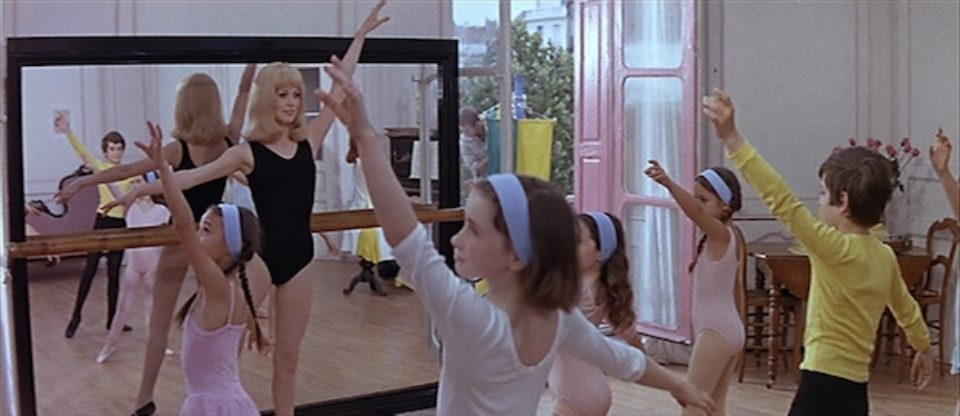
Les Demoiselles de Rochefort (Jacues Demy, 1967)
He makes no attempt whatever at a naturalistic use of color: in every scene, whether indoors or outdoors, costumes and decor blend and harmonize in perfectly balanced patterns. This at times involves changing the “real” world, and the walls and shutters of the houses that surround the central square, for example, are painted in the soft blues and pinks, lilacs and yellows, needed to counterpoint the brighter shades of these colors worn by the dancers. In street scenes away from the square, the same sort of thing happens: in one dance sequence, a little stall painted yellow and blue is kept in view at the right-hand side of the frame, and a cluster of balloons, blue, yellow, green, and orange hangs outside it. These colors are picked up everywhere in the dancers, dressed mainly in green, orange, and blue, and in the yellow and rose of the two sisters moving through the crowd.
The cumulative effect is not just that of a world in which the color correspondences of the clothes worn by the characters gives a clue to their actual or future relationships (the lilac dress of Solange and the pink shirt and mauve jacket of Andy); more than this, the whole visual world seems ready to adapt or respond to the characters themselves—a yellow-colored house is seen on the screen and then Delphine moves into frame, dressed in yellow; in the long-shots of the sisters’ performance at the fair it can be seen that most of the audience is clothed in shades of dark red and dark pink that match their dresses. Throughout the film the two girls wear colors that emphasize sensuality, naturalness, spontaneity—daffodil-yellow, rose, lilac.*
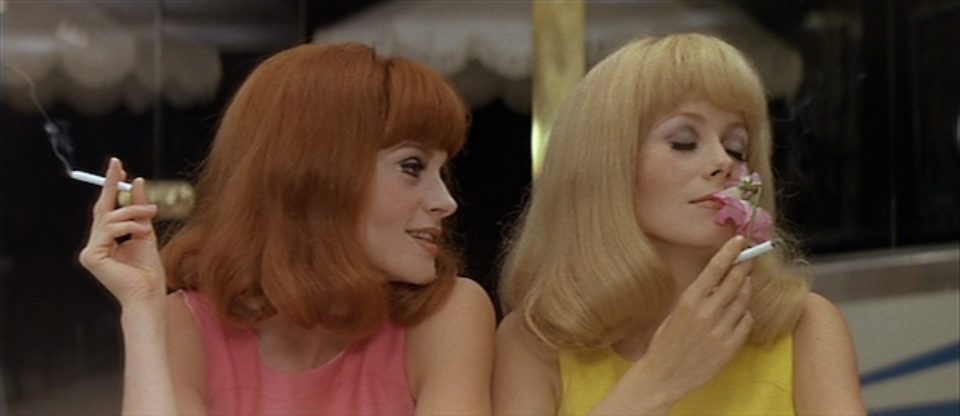
Les Demoiselles de Rochefort (Jacques Demy, 1967)
In Les Demoiselles de Rochefort you use very gentle, harmonizing colors; in Model Shop the colors are very violent. Why is this?
Because it corresponded to my vision of America, which is a gaudy, baroque vision, where the whole idea of taste, this [French] good taste that has been instilled into us like a vaccine, doesn’t exist. American bad taste took me by storm, I loved it. I say “bad taste,” but that’s wrong, one shouldn’t talk about “bad taste,” it’s more an absence of taste, it’s ideas thrown together in a complete muddle and you take what you want out of it. So this debauch of colors took hold of my imagination when I arrived in the United States, and I wanted to recreate this.
Did you find all these things as they were, or did you paint some of them specially?
No, I made it like a documentary, I didn’t touch anything. I filmed what was there, I filmed the reality. On the other hand, with Les Parapluies, I modified everything, I transformed it all. In Model Shop I didn’t want to change anything. Another thing was that I didn’t have much money to make the film and so I had to be content with what I had already. And the reality seemed far finer than any-thing I could have invented myself.
Model Shop is dominated by shriekingly vulgar purples, mauves, bright pinks and dark blues, occasionally combined with bright yellows and greens. The effect, as Demy himself said of the visual impact of Sunset Boulevard, is like a slap in the face. The film makes sustained and systematic use of visual ugliness to create an environment and mood that make any verbal explanation of the central character’s behavior superfluous; in this it modifies a central linguistic code of the cinema that insists on prettiness at almost all costs. There is no escape for George from the visual chaos and harshness around him and even if Demy did not create any particular scenic effects for this film, the relentlessness with which combinations of the basic color pattern follow George around is certainly no accident. He wakes in a room in which every major item of the decor—blanket, poster on the wall, a statuette of an owl, a wigstand—employ the motifs of purple, pink, and blue. He dresses in purple t-shirt and trousers, and his girl appears in a robe that is a hideous efflorescence of purple, blue, pink, yellow, and green. (“hideous” in terms of “good taste,” but vastly exhilarating for the artist and ultimately compulsive for the audience).
She then proceeds to admire herself in a purple-framed mirror with a purple towel hanging near it. (Gloria is also dressed in purple on her two later appearances.) Driving through town in his car he picks up a hitchhiker whose purse is decorated in pink, blue, and yellow, and this combination turns up again in the poster on the wall of the first friend he visits and in the car owned by the friends who run an underground newspaper. Purple or mauve appear in the decor of the friend’s house (the wall), the cafe (the jukebox), parts of the interior and exterior of the model shop itself and the bedspread and pillowcases of the room he is taken to on his first visit and the wallpaper and cushions of his second; it dominates what we are shown of Lola’s apartment, appearing in the bedstead, alarm clock, and lampshade of her bedroom and in her purple and green telephone. Pink is similarly pervasive in all these settings, and much of the interior of the model shop is a garish red.
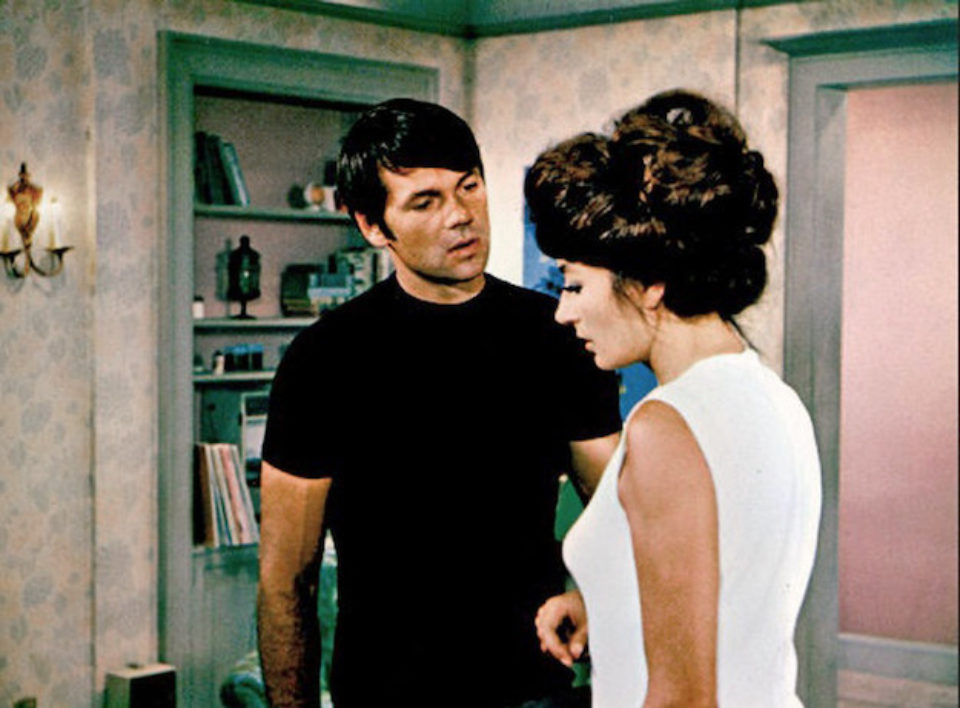
Model Shop (Jacques Demy, 1969)
Peau d’Ane returns to the method of the earlier films with a deliberately artificial and imposed color scheme. Demy says he wanted the film to be very “classical” in its structure, and this effect is achieved to a large extent by the very formal patterning of the colors. On the one hand is the Blue Kingdom of the fairly tale, where lilac, purple, blue and yellow are almost universal-in sheets, furniture, clothing, parrot and even the skin color of the servants (blue); on the other is the Red Kingdom, where scarlet, red, and orange predominate—in sheets, furniture, clothing, and the color of horses and servants (red). A hint of the eventual union between the two is maintained throughout by the chief exception to this contrast—the similarity of color tone and design in the stained glass windows and tapestries of both kingdoms.
Though all four of Demy’s color films are very similar thematically, the effect each makes on the spectator is totally different. It is possible to talk about the use of color in intellectual terms, as I have done so far—to say that in Les Parapluies de Cherbourg the colors separate the world into two opposing factions, while in Les Demoiselles de Rochefort they create a total fusion between the individual and his environment. In Model Shop the relentless use of a very narrow and violent color scheme heightens the sense of disorientation and helplessness that is central to the theme of a character who feels he is trapped in a world that is false and ugly; in Peau d’Ane the cool formality of the color patterns allows us to accept the fairy tale world on its own terms.
But beyond this is the fact that each film is a completely different experience and that this cannot be accounted for by an analysis simply of moral and intellectual ideas. Demy has often said that he works in terms of instinct—“I am like a tree or a plant, and I like to function in that way, because it’s the way in which I live and express myself best”-and that he wants his audiences to try to live through his films in the way in which he himself has done. The color sets a different sensual tone in each film that prompts us to approach each variation of the basic thematic material in a different way. And it achieves this through a systematic violation of normal cinematic principles of “realistic” color and the matching of visual qualities to theme and mood.
*It is always wise, when talking about colors in a film, to take into account that, even with highly-sensitive modern film stock, it is still possible for shades to vary or even change according to differences in lighting from shot to shot, or, if the camera moves so as to bring one color into a different juxtaposition with another, evening the same shot. Deterioration in print quality can also cause color values to alter alarmingly. My comments are made on the basis of viewings of good prints of the films for Les Demoiselles, with occasional, and skeptical, reference to the color reproductions in the script of the film published by Solar.
CORRESPONDENCES
In all his films, Demy employs an intricate and highly-formal narrative structure that is closer to the nineteenth century novel than to most films made within the last two decades. Lola, the first of his features, is still perhaps the most complex, with its series of parallel plots that overlap, reflect, and repeat one another. Each of the main characters has a “double” whose story is a variation or repetition of his or her own: the fourteen year old Cecile resembles Lola (whose own real name is Cecile) at that age; Lola had met a blonde man dressed as an American sailor at a fair on her fourteenth birthday, and Cecile meets a blonde American sailor at a fair on her 14th birthday; Lola is a dancer, Cecile wants to be a dancer; Lola met and fell in love with her sailor years later, and we can assume that Cecile, having run away from home at the end of the film, will repeat this experience too. The sailor Frankie reminds Lola of Michel, her first love. Roland and Frankie both love Lola, but eventually lose her to Michel, and Frankie’s experience with Cecile of course parallels that of Michel with Lola years before.
Even minor references heighten the pervasive sense that everything is somehow interlinked and interwoven: Roland has a 14-year-old sister who resembles Cecile; he tells Mme. Desnoyers that he is going to work for a hairdresser and she mentions that her brother-in-law is a hairdresser in Cherbourg; Michel’s story of being cast away on a Pacific island for several years bears an uncanny resemblance to the plot of a Gary Cooper movie mentioned earlier in the film. Demy makes no attempt to hide the artificiality of this structure; instead he emphasizes it by a careful paralleling of incidents and settings and a series of coincidental encounters and near-misses which bring together one group of characters and keep apart those whose recognition of one another would resolve too soon the symmetry of the plot.
The film begins with Michel coming into Nantes in his white convertible and then Frankie and his friends entering the nightclub and immediately beginning to dance with Lola and the other girls; it ends with a new group of sailors entering the club and bursting into dance, and then Michel (and Lola) leaving Nantes in the white convertible. It is a world where dreams come true (Michel’s mother dreams on the night before he returns that he will come back) and simply thinking of another person enables one to meet him (Roland literally bumps into Lola immediately after he has been reminded of her by Cecile).
Of the later films Les Demoiselles de Rochefort is the closest in its patterning of Lola. Here Demy has a series of characters who are looking or searching for one another but are kept apart by chance and misinformation until the very end of the film. Each of them manages at some stage to pour out his story to at least one of the other characters, but always the one person who could direct him to the object of his search happens not to be present at the time. So Mme. Yvonne and Simon Dame live in the same town for years, each believing that the other is thousands of miles away; Maxence searches for the ideal incarnated in Delphine, but constantly misses her and meets only her sister Solange; Andy, looking for Solange, meets only Delphine and does not know of their relationship. Everything is resolved in the end, of course, in a series of the most blatant yet inevitable coincidences, and the atmosphere of harmony promised throughout by the colors is finally attained.
Baie des Anges and Model Shop, each essentially concerned with two characters only, replace the interweavings and parallels of different plots by a systematic repetition or doubling of incidents and settings. In Baie des Anges the casino and the roulette wheel form the focal point and the characters are constantly drawn back to them, while the theme of gambling itself provides the atmosphere of fate, mystery, chance, and uncertainty achieved by different methods in the other films. In Model Shop the endless drives through the streets of Los Angeles are essential to the theme of searching in the film, but the randomness of this is countered by the deliberate doubling of each major incident—two visits to the model shop itself, two to the camera shop, two to the house on the hill, and so on. Peau d’Ane crystallizes and draws together all these elements, and it was perhaps inevitable that Demy should turn eventually to the overt structure of a fairy tale, with its transformations, mistaken identities, chance yet fated encounters, and the final discovery that the ideal for which one had been searching had been within reach, yet unrecognized, all the time. This element within all the films allows them to build up a logic of their own which can be accepted on a formal level through its associations with a traditional structure, and enables the deliberately simplified characters to take their place as part of a wider pattern.
The overlappings and repetitions are found not just within each film, but often, from one film to another—again very much in the manner of some 19th-century novelists. Roland is a character in both Lola and Les Parapluies de Cherbourg and finds himself caught in a very similar mother-daughter relationship on each occasion; Lola herself reappears in Model Shop. There are recurring visual references, such as the white convertible that turns up in Lola, Baie des Anges, and Model Shop, and the ubiquitous sailors who are either central figures, as in Lola, or pervasive background presences in the street, as in Les Parapluies and Les Demoiselles. And of course each film (except Peau d’Anes is set in a town by the sea—Nantes, Nice, Cherbourg, Rochefort and Los Angeles. Yet within this setting, and despite the fact that the films generally open on an iris-out from the harbour of each particular town, Demy tends to place the action in a recurring series of cafes, bars, shops, apartments, cars, hotel rooms, and streets that are seen only in isolation from their wider surroundings—only in Model Shop do we get a shot that gives us some sense of the city as a whole.
You’re very interested in music in your films?
Yes. It comes from my adolescence. I began making films very young. I was 13 when I began to make films, I bought a camera and made films. At the same time I was interested in literature, painting, and music. I played the violin, I studied painting, and the cinema seemed the best choice for me, for I could express myself as writer, as painter and as musician. That is why I chose cinema, and that’s why I love music in my films so much—as well as colors, words, the performances of the actors, ideas, the camera—everything concerned with filmmaking.
You give them all equal importance?
Yes.
The most noticeable use of music is of course in Les Parapluies de Cherbourg, where Demy produced the first film musical in which every word is sung. Les Demoiselles de Rochefort and, to a lesser extent, Peau d’Ane, are musicals of a more traditional kind, but in all the films music is vital to an understanding of the world Demy is creating. Songs and dances weave their way through Lola and, as is characteristic of Demy, the lyrics of Lola’s songs provide all the information necessary for an understanding of her. Background music is consistently used to underscore relationships and create mood-a muted jazz accompaniment holds the associations of the night club around Lola, unashamedly romantic strings throb during passages of emotion and rise to a climax (with choral assistance) after her quarrel with Roland, and Michel, Lola’s lost hero, appears to the strains of Beethoven’s Seventh. These familiar devices are employed with an irony and sophistication that enable us to adjust correctly to the highly formal patterning of the rest of the film and take the world created for us on its own terms—as an artifact shaped for his own purposes by the filmmaker.
Music is most conspicuously used in Baie des Anges in the ecstatic piano theme that accompanies Jackie’s and Jean’s winning streaks at the roulette table—creating a sense of excitement but also, as the pattern of winning and squandering is established, becoming more and more of an ironic commentary on the action and the characters. The predictability with which the theme recurs helps to shape the repetitive patterns that build up the film.
Michel Legrand’s score for Les Parapluies and Les Demoiselles has been criticized for being too monotonous and one-dimensional. The films, however, are not conventional musicals in which the songs and dances are intended as visual and aural highlights set in contrast to the “normality” of the rest of the action. Here the music blends into and becomes part of the patterns and harmonies created by color, settings and incidents; certain themes are associated with particular characters, relationships or moods, and these are interwoven or played off one against the other, but nothing is allowed to disrupt the integrated pattern of the whole.
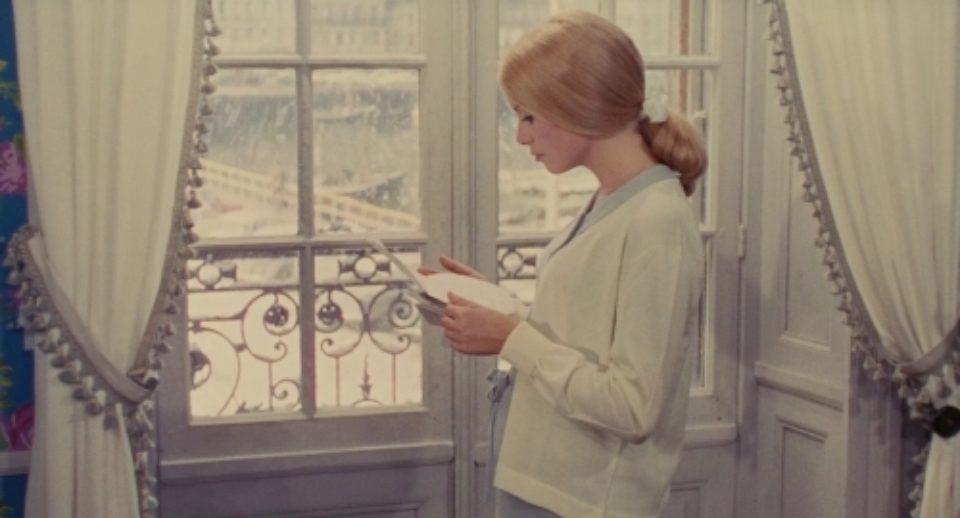
Les Parpluies de Cherbourg (Jacques Demy, 1964)
The main musical “set-piece” in Les Parapluies is the love theme between Guy and Genevieve which is most fully elaborated as they return to Guy’s apartment to spend the night together. It returns later in the film as an ironic juxtaposition to the shot of Genevieve writing to Roland, and in the closing shots as Genevieve drives away after her final meeting with Guy. The tone and mood of this theme, however, blend in with the music used elsewhere in the film, and the chief exception to the basic harmonic structure is the tinkling and haunting piano music that accompanies Guy’s sad encounter with the prostitute Jenny. The deliberate formality of this use of music, however, is most evident in Les Demoiselles, where there are three or four interlinked yet distinct motifs, and the song given to one partner in a love affair is exactly balanced by that given to his as yet unrecognized soulmate—Maxence’s and Delphine’s songs about their ideal loves have the same tune and only slightly different words, and the same is true for Mme. Yvonne and Simon Dame. The sense of harmony is strengthened by the fact that bystanders are apt to join sympathetically in the laments or rejoicings of the central figures-as the customers in the cafe do with Maxence. (This is all handled with the same amused irony that has the dancers in the nightclub burst simultaneously into tears when Lola is finally reunited with Michel.) Like Lola, Delphine and Solange and Bill and Etienne (the two young men who run the carnival) describe themselves as adequately in their songs as is needed for the purposes of the film. And the most important set-piece here, the “Aimer la Vie” song performed by the twin sisters simply crystallizes in words the “message” that the rest of the film has worked upon our senses: “For Les Demoiselles I wanted above all to provide two hours of joy. I was concerned simply to show happiness…”
In his use of color Demy takes an aspect of cinematic language that is generally limited to creating a vague aesthetic sensation in the audience or to convincing them that what they are watching is the “real” world, and modifies this so that color in itself largely conditions our emotional response to the films. He employs a narrative structure that has little of the randomness and the loose ends of ordinary experience and relies far more heavily on coincidence, on people following out apparently destined patterns, than almost any other filmmaker has dared to. He takes the already artificial element of background music and heightens its artificiality, having his characters express themselves in song and dance and creating musical patterns that emphasize our awareness of the way in which the film is shaped. Anyone of these elements used in conjunction with conventional “realism” would prove disastrous; the films succeed because everything in them works together, subtly modifying our relationship to the world presented on the screen before us.
All this is also true of the way in which the camera is used in Demy’s films, though here the style is much more consistent from film to film than is his use of color or music, which tends to vary with the circumstances. Influenced perhaps by Max Ophuls (to whom his first feature was dedicated), Demy keeps his camera in almost constant movement, smoothly and fluidly sweeping around or along with the characters. The result is a camera style that is continually responding or adjusting to the characters, altering relationships between them, bringing them together, in new ways, or separating them. The flowing and graceful movements of the camera impose their own vision of harmony on the films; nothing is frenetic or arbitrary, and everything seems interwoven yet in constant change. In the exceptional cases where the camera remains still for any length of time, the actors themselves tend to act out the patterning, either in dance, or, as in the shots behind the credits of Les Parapluies, in diagonal, horizontal, and vertical movements across the screen which the camera simply observes from overhead.
There is little purely virtuoso or obtrusive camera movement, and where Demy indulges in a particularly long tracking shot, it is always fully integrated into the other movements of the film—the long track back along the station platform in Les Parapluies, for example, that accompanies the train taking Guy away from Genevieve. At the end of the same film, the camera moves away from Guy as he runs out of the office of his filling-station into the snow-apparently after the departing Genevieve but really, as we see when the track continues, to meet the returning Madeleine and Francois. In Peau d’Ane which, being an overt fairy tale is a special case Demy makes use of such camera tricks as slow-motion and backward motion and characters apparently disappearing in the middle of a scene. (Slow motion is used for lyrical effect in the fairground scene of Lola—at a time when it was much less hackneyed than it is now). There is also very little use of editing to create particular artistic effects, Demy preferring to let the camera movements create the necessary juxtaposition and reactions. The patterning of the use of color complements the way in which the camera itself is used, and in the two non-color films, Lola and Baie des Anges, completely different effects are obtained in each case simply from the way in which the black-and-white images are created.
In the first film, Raoul Coutard’s photography is rather harsh and grainy, little attention is paid to composition as such and framing often seems rather haphazard, but the texture of sunlight and open air central to the mood of the film is perfectly rendered. In the second film, Jean Rabier’s photography concentrates on visual contrasts that suit the alternations and reversals of the film: smooth dazzling whites are constantly set against rich blacks, and the characters tend to be dressed in white or black and to be juxtaposed against backgrounds of whatever color is the opposite at the time. Recurring reflections in glass or against marble pillars emphasize the dual aspects of the characters’ personalities, and the film delights in the sensuous textures of sea, stone, marble, feathers, and hair.
DISCONTINUITIES
In your films people suffer, they experience pain and fear, yet the background, the colors, the music, are always beautiful. Do you think there is a conflict there?
I don’t think so, because that’s how life is. We live, we suffer, and yet music is beautiful, colors are beautiful; even though we are going through the worst troubles and sufferings, red is always lovely, blue is always lovely, and the music of Mozart is always beautiful—even if you have the worst political problems… It’s a contradiction, you can call it a contradiction, not a conflict. So why not use it? Just because my characters may suffer terribly, that’s no reason to surround them with hideous, ugly colors or put in grating music. That would be superfluous.
In almost all Demy’s films characters tend to fall in love at first sight and to remain faithful to this first love despite all separation or adversity, or they have an ideal for which they are searching that is finally attained at the end of the film. Even in a film which ends unhappily, like Les Parapluies de Cherbourg, it is clearly implied that, however content Guy may be with Madeleine, it is Genevieve who will always be his real love and that Genevieve is fully aware of how much her betrayal has cost her. This is a vision of life that has seemed totally unreal or sentimental to many critics, and the ideas of the coup de foudre and the consuming passion (whether for a lover or for something like gambling, as in Baie des Anges) are particularly alien to Anglo-Saxons.
One way of defending Demy, therefore, has been to point out that his films are as much concerned with pain, war, death and loss as they are with happiness and ideal love. Les Parapluies de Cherbourg has an astonishingly high death rate for a work often seen as pure mindless escapism: Guy’s aunt and Genevieve’s mother both die in the course of the film, Guy’s letters from Algeria talk about friends being killed, and he himself returns crippled by the war. We hear in Les Demoiselles de Rochefort of a dancer called Lola—Lola being brutally hacked to pieces (and the murderer turns out to be a nice old man seen earlier in the film). Guy in Les Parapluies and George in Model Shop receive their call-up papers and are very conscious of the idea of killing others or themselves being killed in war. Most of the characters are fundamentally very lonely and the happiness usually granted them at the end has to be set against this. Lola spends years of her life waiting for the return of the man who has deserted her; Jackie in Baie des Anges is cut off from normal human relationships by her compulsion for gambling, and her return to Jean at the end of the film can easily be seen as simply the beginning of an-other phase of an endlessly unsatisfactory cycle; George in Model Shop is disoriented and aimless, unable to find the real companionship he needs in either his friends or his girl. The clearest indication of this aspect of the films, however, is the series of lonely middle-aged mothers, conscious that they are themselves still physically attractive, and luring young men towards their daughters more as a boost to their own egos than for any other reaso—Mme. Desnoyers in Lola, Genevieve’s mother in Les Parapluies, Mme. Yvonne in Les Demoiselles—and of these only Mme. Yvonne is granted a happiness of her own.
Set against the happy lovers are those who fail or are left aside, whose love is betrayed or destroyed—Roland and Frankie in Lola, Guy and, in effect, Madeleine in Les Parapluies is concerned with the theme of voyeurism that is submerged in most of the others-the idea of characters hanging around the fringes of other people’s love affairs, yet unable to participate themselves.
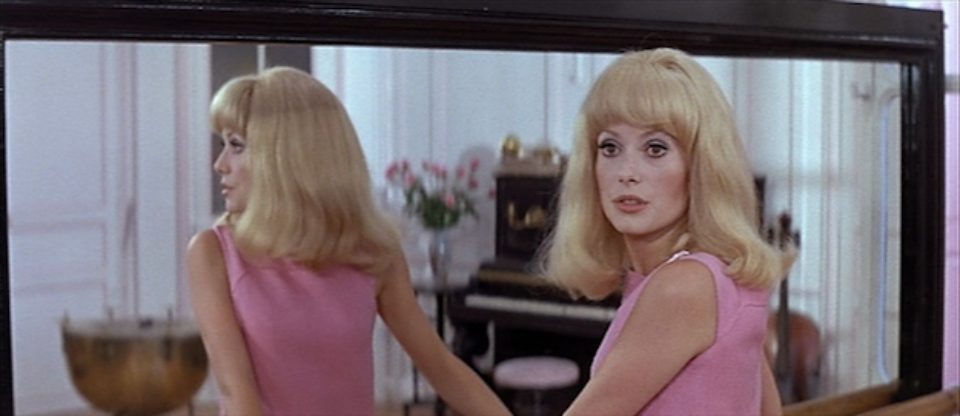
Les Demoiselles de Rochefort (Jacques Demy, 1967)
But simply to list all these elements does little more than acknowledge that Demy’s world has the variety we would expect from any artist worth taking seriously. And to limit oneself solely to this aspect of his films brings one up against the awkward fact that very few of his characters have much complexity or depth, and that he tends to work with stock characters and recurring types.
You like working with actors?
Yes. What I like about actors is that—in French you say “jouer,” in English “play”—and I like to play. I approach it in a childlike way—when you are a child you play at cops and robbers and so on, and the fact of playing on a stage with actors is still like playing as a child. I like that very much.
In your films the women are generally more interesting and stronger than the men.
Women in my films have to surprise, to astonish; the men are always calmer, more well-behaved. The mixture of the two, the contrast, interests me—the woman more brilliant, joyous, or extravagent, this play between the restrained man and this exuberant woman creates a mixture, a dialogue that I like… I like women who are witty, amusing, beautiful, who have something fanciful about them; even if, like Lola, she has problems that cause her sadness, she remains despite this amusing and full of life and sympathetic. The man is always more reserved with relation to the woman.
Do you think it’s like this in life?
In my life. But not perhaps in your or someone else’s.
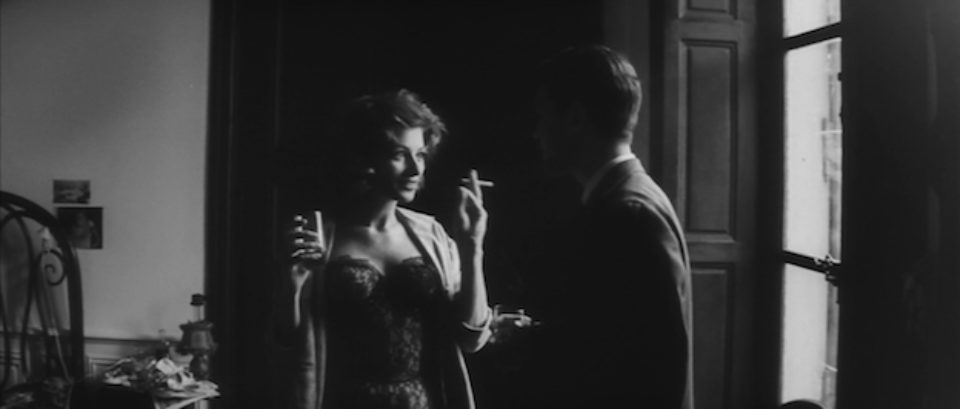
Lola (Jacques Demy, 1961)
Demy consistently reverses the normal film code that has the woman as a beautiful, rather mindless object and gives the most interesting mental and physical activities to the man. In Demy’s films it is the men who are generally beautiful objects, quiet, sad-eyed, blonde and melancholy, at the mercy of fate and circumstances. The women, though almost equally controlled by fate, have a vitality and spontaneity that allow them to take charge of at least part of their own destiny. Yet they take on life largely through the women who incarnate them on the screen, actresses of the calibre of Jeanne Moreau, Anouk Aimee and Catherine Deneuve, and though they have sufficient interest to hold their place in the overall scheme, the world that Demy creates does not depend solely on the people who inhabit it or on the moral ideas expressed through them.
The characters exist as part of the total pattern—of color, sound, movement, narrative structure, personal relationships—that goes to make up the completed film. They blend into this and have their role to play, but they cannot be understood if they are abstracted from the “systematic and unexpected variations of the mode of language, of narrative, or of existing [cinematic] forms.” In his use of the other elements in the pattern Demy is concerned with imposing his own personal vision without much regard to the conventions of realistic cinema; rather he emphasizes and exploits the artifice inherent in film itself. The meaning of his work emerges from the deliberate discontinuities set up between the nature of the subject and the method of treating it, for these force us to reassess our relationship to the screen image and to the world that it presents.
Why do you make films? To teach people something? to give them pleasure? to amuse yourself?
I started out, when I was twenty and beginning to make films, with what you might call certain moral principles. I wanted to show men and women, human beings, in what you might call noble situations, with aspirations, desires, ambitions, who are never debased by what happens to them, and who express courage, the desire to continue, to go on living, and my ambition stopped there. And for each film I asked myself the same question. In Les Parapluies it was a matter of love and unfaithfulness and to make people aware of how serious that situation of such a love affair was in the context of the Algerian War, and this seemed essential to me. For Les Demoiselles I wanted above all to provide two hours of joy. I was concerned simply to show happiness, and this relates to another concept of cinema I’ve always held. This can be explained in this way: when I was a student in Paris, I was lonely, really alone, I didn’t know anyone, I had very few friends, I was unhappy and often depressed, because I didn’t see at all how I could get to make films some day—I didn’t know anyone and I was up against a blank wall. In such moments of despair I would go to see, for example, Renoir’s The River, and I would come out—how can I express it?—exalted, quite exalted, right on top of the world, ready to overcome everything. Nowadays, when people talk about confrontation and revolution in the world, I make my own revolution when I come out of a film by Renoir, and I can say that for me that is what cinema is all about, it’s what gives me courage, the desire to live and to go on living. And in my films that’s all I’ve tried.
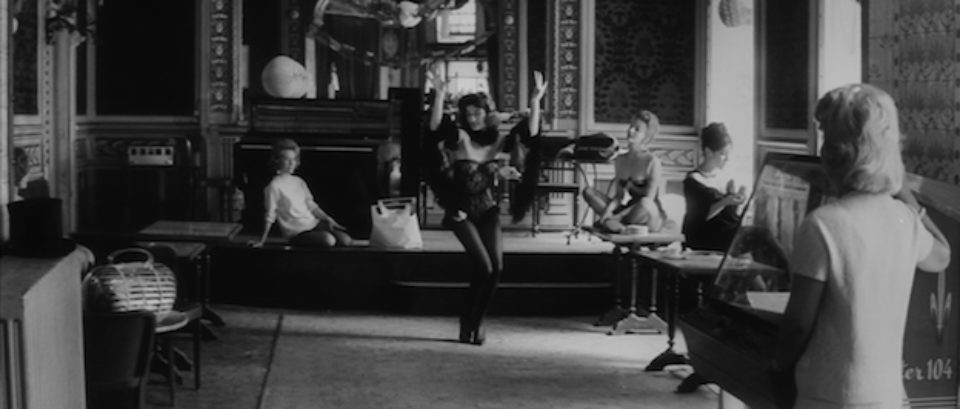
Lola (Jacques Demy, 1961)
JACQUES DEMY FILMOGRAPHY
1960
LOLA. Films Around the World; screenplay Jacques Demy;’cinematography Raoul Coutard; cast Anouk Aimee, Marc Michel, Elina Labourdette, Allen Scott. Distributed in 16mm by Contemporary Films McGraw-Hill.
1962
LUST. (An episode from LES SEPT PECHES CAPITAUX). Embassy Pictures; screenplay Demy; based on an idea by Roger Peyrefitte; cast Laurent Terzieff and Jean-Louis Trintignant. Distributed in 16mm by Audio / Brandon.
LE BAIE DES ANGES. (BAY OF ANGELS). Pathe Contemporary; screenplay Demy; cinematography Jean Rabier; cast Jeanne Moreau and Claude Mann. Distributed in 16mm by Contemporary Films McGraw-Hill.
1964
LES PARAPLUIES DE CHERBOURG. Landau Unger; screenplay and lyrics Demy; music Michel Legrand; cinematography Jean Rabier; cast Catherine Deneuve, Nino Castelnuovo, Marc Michel, Ellen Farner, Anne Vernon.
1967
LES DEMOISELLES DE ROCHEFORT. Warner Brothers; screenplay Demy; music Michel Legrand; cinematography Ghislain Cloquet; cast Catherine Deneuve, Francoise Dorleac, Gene Kelly, George Chakiris, Danielle Darrieux.
1968
THE MODEL SHOP. Columbia; screenplay Demy; English dialogue Adrien Joyce; cinematography Michel Hugo; cast Anouk Aimee, Gary Lockwood, Alexandra Hay, Carol Cole.
1970
PEAU D’ANE. screenplay Demy; from a fairy tale by Charles De Perrault; cinematography Ghislain Cloquet; cast Catherine Deneuve, Jean Marais, Jacques Perrin, Delphine Seyrig.
1971
PIED PIPER. A work in progress starring Donovan.



